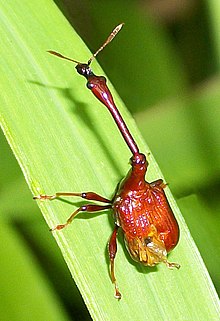Attelabidae
| Attelabidae | |
|---|---|
 | |
Cycnotrachelus longicollis in India | |
Scientific classification | |
| Kingdom: | Animalia |
| Phylum: | Arthropoda |
| Class: | Insecta |
| Order: | Coleoptera |
| Superfamily: | Curculionoidea |
| Family: | Attelabidae Billberg, 1820 |
| Subfamilies | |
Attelabinae - leaf-rolling weevils | |
The Attelabidae is a widespread family of weevils.[1] They are among the primitive weevils, because of their straight antennae, which are inserted near the base of the rostrum. The prothorax is much narrower than the base of the elytra on the abdomen. Attelabidae and the related family Rhynchitidae are known commonly as the leaf-rolling weevils.[2] Rhynchitidae may be treated as subfamily Rhychitinae of the Attelabidae.
Some members of this family have long necks and may be called giraffe weevils, particularly Trachelophorus giraffa. A few species are minor agricultural pests. The larvae of Rhynchitinae feed in flower buds, fruits, and terminal shoots, or are leaf miners. The subfamily Attelabinae are the true leaf rollers. The female cuts slits into leaves to deposit her eggs, and rolls that part of the leaf in which the larvae will feed.
Contents
1 Taxonomy
1.1 Selected genera
1.2 Tree
2 References
3 External links
Taxonomy
Selected genera
- Apoderus
- Attelabus
- Cycnotrachelus
Eleuscelus[2]- Euops
Paralleuscelus[2]
Pareleuscelus[2]
Pheleuscelus[2]
Sawadaeuops[2]
Suniops[3]- Trachelophorus
Tree
The phylogenetic position of the family within the Curculionoidea based on 18S ribosomal DNA and morphological data can be illustrated in a tree:[4].mw-parser-output table.cladeborder-spacing:0;margin:0;font-size:100%;line-height:100%;border-collapse:separate;width:auto.mw-parser-output table.clade table.cladewidth:100%.mw-parser-output table.clade tdborder:0;padding:0;vertical-align:middle;text-align:center.mw-parser-output table.clade td.clade-labelwidth:0.8em;border:0;padding:0 0.2em;vertical-align:bottom;text-align:center.mw-parser-output table.clade td.clade-slabelborder:0;padding:0 0.2em;vertical-align:top;text-align:center.mw-parser-output table.clade td.clade-barvertical-align:middle;text-align:left;padding:0 0.5em.mw-parser-output table.clade td.clade-leafborder:0;padding:0;text-align:left;vertical-align:middle.mw-parser-output table.clade td.clade-leafRborder:0;padding:0;text-align:right
| |
| ||||||||||||||||||||||||||||||||||||
| |
References
^ Riedel, A. (2014). 3.4 Attelabidae Billberg, 1820. In: Leschen R.A.B. & Beutel, R.G. (Eds) Handbook of Zoology, Coleoptera, Beetles Volume 3: Morphology and Systematics (Phytophaga). DeGruyter, Berlin, pp. 328–355.
^ abcdef Legalov, A. A. (2004). New data of the leaf-rolling weevils (Coleoptera: Rhynchitidae, Attelabidae) of the world fauna with description of 35 new taxons. Baltic Journal of Coleopterology 4(1) 63-88.
^ Legalov, A. A. and N. Liu. (2005). New leaf-rolling weevils (Coleoptera: Rhynchitidae, Attelabidae) from China. Baltic Journal of Coleopterology 5(2) 99-132.
^ Marvaldi, A. E.; et al. (2002). "Molecular and morphological phylogenetics of weevils (Coleoptera, Curculionoidea): do niche shifts accompany diversification?". Systematic Biology. 51 (5): 761–785. doi:10.1080/10635150290102465. PMID 12396590..mw-parser-output cite.citationfont-style:inherit.mw-parser-output qquotes:"""""""'""'".mw-parser-output code.cs1-codecolor:inherit;background:inherit;border:inherit;padding:inherit.mw-parser-output .cs1-lock-free abackground:url("//upload.wikimedia.org/wikipedia/commons/thumb/6/65/Lock-green.svg/9px-Lock-green.svg.png")no-repeat;background-position:right .1em center.mw-parser-output .cs1-lock-limited a,.mw-parser-output .cs1-lock-registration abackground:url("//upload.wikimedia.org/wikipedia/commons/thumb/d/d6/Lock-gray-alt-2.svg/9px-Lock-gray-alt-2.svg.png")no-repeat;background-position:right .1em center.mw-parser-output .cs1-lock-subscription abackground:url("//upload.wikimedia.org/wikipedia/commons/thumb/a/aa/Lock-red-alt-2.svg/9px-Lock-red-alt-2.svg.png")no-repeat;background-position:right .1em center.mw-parser-output .cs1-subscription,.mw-parser-output .cs1-registrationcolor:#555.mw-parser-output .cs1-subscription span,.mw-parser-output .cs1-registration spanborder-bottom:1px dotted;cursor:help.mw-parser-output .cs1-hidden-errordisplay:none;font-size:100%.mw-parser-output .cs1-visible-errorfont-size:100%.mw-parser-output .cs1-subscription,.mw-parser-output .cs1-registration,.mw-parser-output .cs1-formatfont-size:95%.mw-parser-output .cs1-kern-left,.mw-parser-output .cs1-kern-wl-leftpadding-left:0.2em.mw-parser-output .cs1-kern-right,.mw-parser-output .cs1-kern-wl-rightpadding-right:0.2em
External links
- Bugguide
- Korean Attelabidae
Homoeolabus analis on the UF / IFAS Featured Creatures Web site
Wikispecies has information related to Attelabidae |
This Attelabidae-related article is a stub. You can help Wikipedia by expanding it. |
